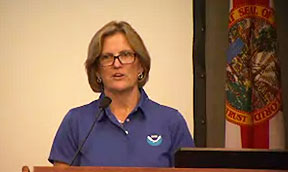 [SatNews] The deputy administrator for NOAA stressed the need for continued funding of advanced weather forecasting technology...
[SatNews] The deputy administrator for NOAA stressed the need for continued funding of advanced weather forecasting technology...

Dr. Kathryn Sullivan at the EDC event.
"Our polar and geostationary satellites are the backbone of the nation's weather enterprise," said Sullivan. "It is critical that we keep NOAA's weather programs funded, even in this tight fiscal environment." Among the programs she discussed is the next generation of NOAA's Geostationary Operational Environmental Satellites (GOES). Today's GOES satellites are a significant tool used by NOAA to detect and track hurricanes, thunderstorms, tornadoes and other severe weather in the continental U.S. and western hemisphere. The next generation of this program, the GOES Series-R (GOES-R), is expected to significantly speed severe weather prediction and warnings by processing and delivering 40 times more data than is possible today to NOAA's National Weather Service and more than 10,000 direct users. GOES-R also will vastly improve image resolution and increase the rate of imagery coverage of Earth's surfaces from every 30 minutes to every five minutes in normal conditions — and every 30 seconds during severe weather events. In addition, the GOES-R system will provide a new capability for continuous monitoring of total lightning activity, which provides early indication of storm intensification and severe weather events, including improved tornado warning lead time. The first launch of a GOES-R series satellite is scheduled for 2015.
Harris is the prime contractor for the ground segment of GOES-R, a 10-year contract with a potential value of $736 million. More than 380 people from Harris and its subcontractors work on the GOES-R program nationwide, with nearly 240 of those people directly employed by Harris and based in the Melbourne-area. The ground segment encompasses receiving and processing of satellite data, generating and distributing products from satellite data, and command and control of operational satellites.

